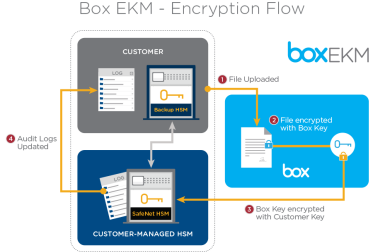Category: Cloud HSM
Box Enterprise Key Management – Powered by AWS CloudHSM

In a post on the Box Blog, co-founder Aaron Levie rolled out the new Box Enterprise Key Management (EKM) offering. This product was designed to allow companies to use Box’s content management and collaboration tools while retaining control over their own encryption keys. As he notes in the post, Enterprise Key Management is powered by AWS CloudHSM (read my post, AWS CloudHSM – Secure Key Storage and Cryptographic Operations, to learn more).
Aaron’s post recounts the multi-year journey that they took to get to this point. After exploring and ultimately discarding hybrid systems and client-side encryption, they decided to work with AWS and SafeNet to build a no-compromise (his words) system that balanced ease of use and customer control.
When a customer decides to use EKM, they work with Box to provision a CloudHSM in AWS and an on-premises backup in the customer’s own data center, all connected by secure, dedicated connections.
This model gives each Box customer exclusive control over the keys that are used to encrypt their files (according to the post, a unique key is used for each version of every file stored in Box). the system also maintains a complete set of immutable access logs.
To learn more, read Aaron’s post!
— Jeff;
Use Your own Encryption Keys with S3’s Server-Side Encryption
Amazon S3 stores trillions of objects and processes more than a million requests per second for them.
As the number of use cases for S3 has grown, so have the requests for additional ways to protect data in motion (as it travels to and from S3) and at rest (while it is stored). The first requirement is met by the use of SSL, which has been supported by S3 from the very beginning. There are several options for the protection of data at rest. First, users of the AWS SDKs for Ruby and Java can also use client-side encryption to encrypt data before it leaves the client environment. Second, any S3 user can opt to use server-side encryption.
Today we are enhancing S3’s support for server-side encryption by giving you the option to provide your own keys. You now have a choice — you can use the existing server-side encryption model and let AWS manage your keys, or you can manage your own keys and benefit from all of the other advantages offered by server-side encryption.
You now have the option to store data in S3 using keys that you manage, without having to build, maintain, and scale your own client-side encryption fleet, as many of our customers have done in the past.
Use Your Keys
This new feature is accessible via the S3 APIs and is very easy to use. You simply supply your encryption key as part of a PUT and S3 will take care of the rest. It will use your key to apply AES-256 encryption to your data, compute a one-way hash (checksum) of the key, and then expeditiously remove the key from memory. It will return the checksum as part of the response, and will also store the checksum with the object. Here’s the flow:

Later, when you need the object, you simply supply the same key as part of a GET. S3 will decrypt the object (after verifying that the stored checksum matches that of the supplied key) and return the decrypted object, once again taking care to expeditiously remove the key from memory.
Key Management
In between, it is up to you to manage your encryption keys and to make sure that you know which keys were used to encrypt each object. You can store your keys on-premises or you can use AWS Cloud HSM, which uses dedicated hardware to help you to meet corporate, contractual and regulatory compliance requirements for data security.
If you enable S3’s versioning feature and store multiple versions of an object, you are responsible for tracking the relationship between objects, object versions, and keys so that you can supply the proper key when the time comes to decrypt a particular version of an object. Similarly, if you use S3’s Lifecycle rules to arrange for an eventual transition to Glacier, you must first restore the object to S3 and then retrieve the object using the key that was used to encrypt it.
If you need to change the key associated with an object, you can invoke S3’s COPY operation, passing in the old and the new keys as parameters. You’ll want to mirror this change within your key management system, of course!
Ready to Encrypt
This feature is available now and you can start using it today. There is no extra charge for encryption, and there’s no observable effect on PUT or GET performance. To learn more, read the documentation on Server Side Encryption With Customer Keys.
— Jeff;
